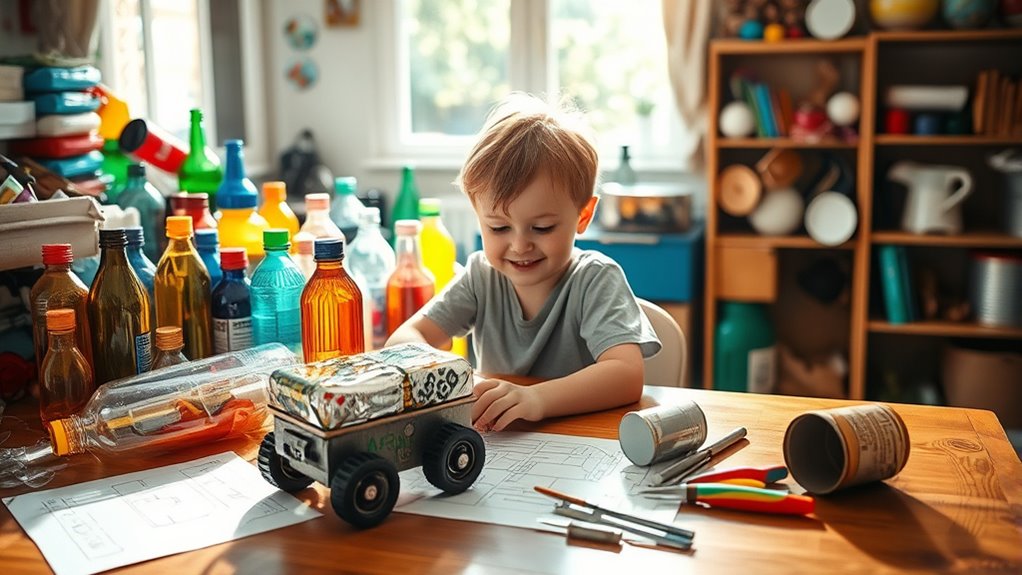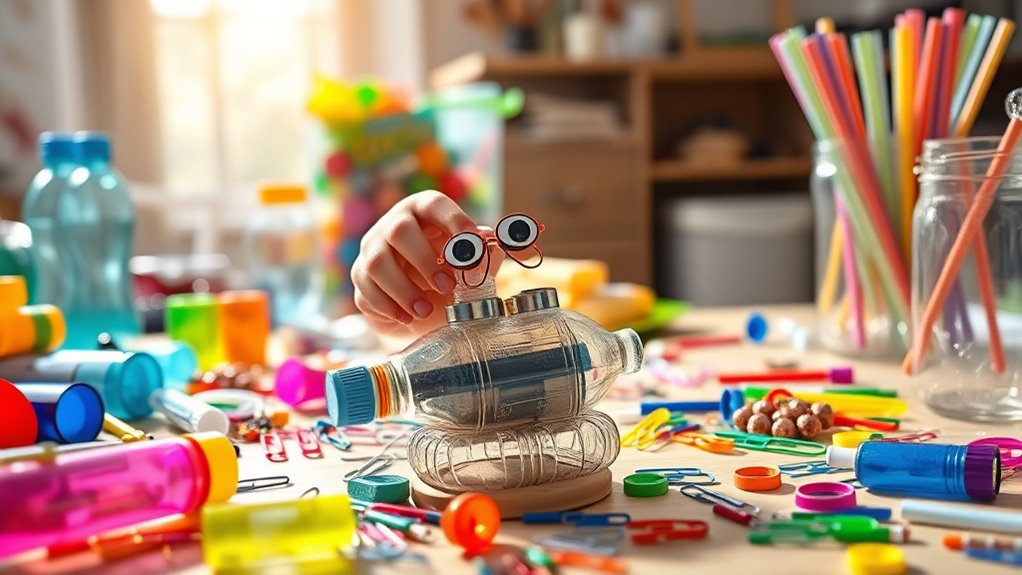You can have fun with STEM play at home using recyclables by creating hands-on projects that teach environmental responsibility and problem-solving. Build towers from cardboard and bottles, design simple machines from bottle caps and egg cartons, or craft miniature robots from cardboard boxes. These activities boost creativity, critical thinking, and resourcefulness while making learning enjoyable. Keep exploring for creative ideas and tips to turn everyday trash into educational adventures that inspire curiosity and sustainable habits.
Key Takeaways
- Incorporate themed challenges like building towers or robots with recyclable materials to boost engagement.
- Use everyday recyclables such as bottles, caps, and cardboard to create STEM projects that encourage problem-solving.
- Promote sustainability education by teaching kids about waste reduction and resourcefulness through hands-on activities.
- Encourage experimentation and creativity by allowing children to modify projects, fostering perseverance and confidence.
- Connect projects to real-world environmental issues to make STEM play meaningful and instill environmental responsibility.

Have you ever wondered how to make learning science, technology, engineering, and math fun and engaging at home? One fantastic way is by turning recyclables into creative STEM projects. Not only does this approach teach kids about environmental responsibility, but it also challenges them to think critically about recycling challenges and how they can repurpose everyday items. When you start exploring creative craft ideas using used materials, you open the door to endless possibilities that combine learning and play seamlessly.
Recycling challenges can seem overwhelming at first, but they serve as excellent opportunities to spark innovation. For example, you might challenge your kids to build the tallest tower using only plastic bottles and scrap cardboard. This activity encourages problem-solving and understanding of structural engineering principles. By setting limits on what materials can be used, you help children think creatively about how to maximize their resources. They learn that constraints often lead to more inventive solutions, which is a core concept in STEM fields.
Turning recyclables into STEM projects sparks creativity and problem-solving skills through fun, resourceful building challenges.
Creative craft ideas using recyclables are not only educational but also incredibly fun. You can guide your kids to turn old cardboard boxes into miniature robots or space shuttles. Using bottle caps, egg cartons, and paper rolls, they can design simple machines or even mechanical devices that move. These projects foster curiosity about mechanical engineering and physics, making abstract concepts tangible and accessible. Plus, every completed craft becomes a proud display of their ingenuity, boosting confidence and perseverance.
Involving your children in these activities also provides a practical lesson in sustainability. As they work with recyclable materials, you can discuss why reducing waste matters and how reusing items helps the environment. This real-world application reinforces lessons they might learn in school about conservation and resourcefulness. Furthermore, it’s an excellent way to teach responsibility, patience, and attention to detail—traits that are crucial in STEM careers.
To keep things fresh and exciting, you can set themed challenges or create storylines around the projects. For example, turn the activity into building a city from recyclables or designing a robot to solve a specific problem. These imaginative scenarios make the learning process more immersive and memorable. The key is to stay flexible and encourage experimentation, reminding your child that mistakes are part of learning and that their creativity is the most valuable tool.
In short, using recyclables for STEM play at home turns everyday trash into treasure. It challenges your children to think critically about recycling challenges, inspires creative craft ideas, and nurtures a love of learning—all while making the process fun and engaging. Harnessing the power of problem-solving skills during these activities helps develop a mindset that benefits them well beyond childhood.
Frequently Asked Questions
How Can I Ensure Safety During STEM Activities With Recyclables?
To guarantee safety during STEM activities with recyclables, always wear safety gear like goggles and gloves to protect against sharp edges or small parts. Supervision tips include closely monitoring children, demonstrating proper handling, and setting clear rules. Keep a first aid kit nearby and encourage kids to ask questions if they’re unsure. By staying vigilant and prepared, you create a safe environment that fosters learning and creativity.
What Age Group Is Best Suited for Recyclable STEM Projects?
You can confidently introduce recyclable STEM projects to children aged 3 to 12, as these activities are easily tailored to their developmental considerations. For younger kids, focus on simple, age-appropriate activities like building with cardboard or sorting recyclables. As they grow, encourage more complex projects that challenge their problem-solving skills and creativity. Always adapt tasks to their developmental level, ensuring safety and engagement while sparking curiosity.
How Do I Introduce STEM Concepts to Young Children Effectively?
To introduce STEM concepts effectively to young children, focus on early childhood, hands-on learning. Engage their curiosity with simple, fun activities using recyclables, like building structures or exploring shapes. Use clear, age-appropriate language, and encourage questions and experimentation. Keep sessions short and playful, allowing kids to explore freely. This approach helps them develop a love for STEM while making learning enjoyable and accessible.
Are There Recommended Recyclable Materials for Specific STEM Experiments?
You should choose appropriate materials like cardboard tubes, plastic bottles, and aluminum cans for STEM experiments, ensuring they’re clean and safe for children. Always supervise their use, and teach safe disposal practices afterward. Avoid sharp or broken items, and consider recycling guidelines to promote environmental responsibility. Using these recyclable materials makes experiments engaging and eco-friendly, helping children understand sustainability while exploring STEM concepts effectively.
How Can I Assess My Child’s Learning During Recyclable STEM Play?
Think of evaluating your child’s learning as tuning a musical instrument. You can use observation techniques to watch how they approach challenges, encouraging exploration and problem-solving. Track their progress by noting their ability to build, innovate, and explain concepts. Ask open-ended questions to gauge understanding, and celebrate their successes. This active monitoring helps you see their growth, much like fine-tuning a melody, ensuring they develop essential STEM skills through recyclable play.
Conclusion
By using recyclables for STEM play at home, you open endless creative possibilities. Imagine a child designing a sturdy bridge from cardboard and bottle caps, learning engineering principles while having fun. This simple activity not only sparks curiosity but also builds problem-solving skills. So, gather those recyclables, set up a mini project, and watch your child’s confidence grow as they invent and explore—proving that learning can be both eco-friendly and exciting!










